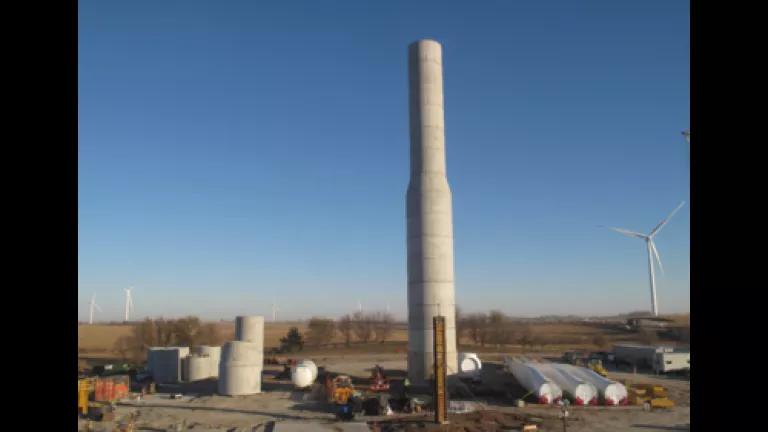A Tall Wind Turbine Tower Can Herald Clean Energy Advances in Southeast and Midwest, with Congress' Help

News last week that a concrete wind turbine tower almost 115 meters tall is being built as part of a new Iowa wind farm might seem exciting only to energy wonks like me. But it shouldn't be, because it can herald something really big, if Congress gets its house in order.
Now under construction in Iowa and pictured here, the nation's tallest wind turbine can herald great things for clean energy and the nation as a whole if Congress chooses to support the Production Tax Credit for Wind Power. (Photo: MidAmerican Energy)
The average American wind turbine tower is only about 85 meters tall. But taller ones, especially those 110 meters and taller, can produce more power more cost-effectively, because they access the stronger winds present at higher altitudes. That, in and of itself, is big news.
But here's news that's even bigger: With taller towers, regions and states, like the Southeast and parts of the Great Lakes, that have been partial or total wind power write-offs can now take advantage of all wind power has to offer. We're talking here about lower carbon emissions from our electric system, good-paying jobs, cleaner air for our kids to breathe, and serious energy-bill savings. That's impressive stuff to be sure. And taller towers, already deployed throughout the world, can also help states cost-effectively comply with the Environmental Protection Agency's Clean Power Plan to cut carbon pollution from the country's electric system. In fact, taller turbine towers can be a boon for the entire nation. (To find out just how much good these taller towers can do, check out this important report by the US Department of Energy.)
Spreading to new parts of the country, operating higher, and being able to generate power at slower wind speeds are all advantages for taller turbines. But they do pose new and different questions for how wind power and wildlife interact. That's why the work of groups like the American Wind Wildlife Institute is more important than ever.
There are a couple of hitches to the increased deployment of taller towers and to wind-wildlife research, though: Congress' current failure to extend the Production Tax Credit, a clean energy tax incentive for wind power, that expired at the end of last year, and Congress' failure to support DOE's wind research budget request. Congress is now considering extending the PTC as part of a package of so-called tax extenders--tax breaks that aren't written into the nation's permanent tax code, as fossil fuel incentives are--but there's considerable pushback by Congressional foes of clean energy. Ditto the wind research budget.
"The uncertainty about the PTC makes it difficult for developers to commit to these projects," explains Chris Palumbo, of the Tindall Corporation, a turbine-tower manufacture. Palumbo says there's even more innovation and more cost-effective clean energy to be had, if the US takes the path that other national governments have chosen. "Incentives everywhere else tell you to build higher," he says. "But that's not the way it is here, because we're competing with other energy sources that get other incentives that are more attractive."
It doesn't have to be that way. Congress can extend the PTC and the many benefits that come with it. "We continue to look at new technology that can help us deliver more wind energy," explains Ruth Comer, a spokesperson for the Midwestern utility that's building the 154-megawatt wind farm where this new tall tower will be located. Let's hope Congress matches their efforts turn for turn and measure for measure.

